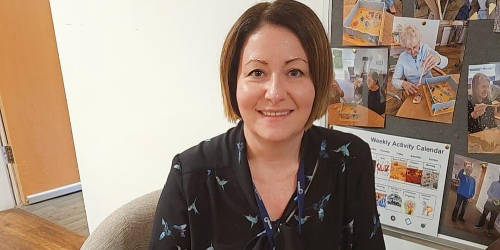- Home
- News & events
- Blog
- Supporting our trans and non-binary colleagues
22 April 2024
Supporting our trans and non-binary colleagues
In his blog our Diversity and Inclusion (D&I) Officer Henry talks about the importance of having guidance on supporting trans and non-binary colleagues and discusses the approach we have taken to getting ours right. 
It goes without saying that everyone should feel comfortable in life, and at Anchor, we encourage everyone to bring their best selves to work. When people feel happy and safe, the workplace is a more supportive and productive place.
However, there is evidence to suggest that trans and non-binary people often leave their jobs before transitioning or coming out and often take lower paid jobs when they return to the workplace because they are concerned about possible bullying or discrimination they will face if they stay. Around two thirds of trans and non-binary people choose not to reveal their gender identity at work.
The process of transitioning can, for many people, be rather complicated, especially when so much depends on individual circumstances. In workplaces, support often seems to be directed at line managers so they can help trans people feel comfortable. This is wonderful, of course, but often assumes the first step: that the trans person themself knows they can ask their line manager for support, and beyond that, where else they can expect support in the workplace.
At Anchor, we have refreshed our guidance for supporting our trans and non-binary colleagues, and wanted to share our approach so that others can use what’s helpful to them.
An approach to creating clear guidance for all colleagues
Work out what you have
When looking to offer support to a group, it’s helpful to consider your starting point. This could be in terms of culture (is everyone in your workplace equipped to offer this support?), policy and written documents (what are people already familiar with?), and even the wider context (can the workplace offer support where the wider world cannot?).
We already had a guidance document for managers to support their trans colleagues, but it assumed that the colleague knew where to go and how to ask for that help. Additionally, we have Gold status as an Inclusive Employer, and are a Diversity Champion with Stonewall. All this provided a very helpful foundation and meant that we have a sturdy basis on which to build further support into our workplace culture.
Work out what’s missing
After searching the internet, I found very little advice for trans people (and even less for non-binary people) in the workplace. As a trans man myself, I know how important it is to be transparent and explicit in the support that organisations provide. Since my own experience in previous jobs had been inconsistent and sometimes quite harmful, I wanted to create some guidance for trans and non-binary individuals, as it’s not always as obvious as we’d hope that we’re supported!
So despite our good foundations, we weren’t speaking to the colleagues directly affected by their transitions or giving them the support to lead on their transitions. Trans and non-binary individuals seemed very passive in the guidance document that we had, and while support was signposted elsewhere there was nothing in this document.
We wanted to open the audience of this guidance up to trans individuals too, and make explicit what support was available and where people could go for it. We also knew that, while the line manager is an integral part of providing support for someone who may be transitioning or considering transitioning in the workplace, we wanted to include other means of support.
One of the first practical steps we took was to talk to our Rainbow Network, which is a colleague-led group to support Anchor’s LGBTQ+ colleagues. With some feedback from them, we decided on breaking up the section for colleagues into several parts:
- Questioning your gender identity – coming to work while you may be questioning can be tough, so this section was aiming to provide some initial signposts to people to talk to, or resources to help this internal journey.
- Transitioning at work – this section considered the more practical steps and was essentially the line manager’s guidance but from the colleague’s perspective.
- Being trans at work – we thought it was very important that support didn’t end just when a person is “outwardly transitioning.” Often a trans person will have to come out continuously at work, and even if they don’t, their identity should still be supported fully.
- Supporting a trans person – on suggestion from the Rainbow Network, it was suggested that a note on how to support trans people would be helpful to include. This started as a bit of advice for parents of trans people, but also encompasses having a trans colleague or friend.
Another aspect to consider is that very few workplaces are perfect. While we rightfully want to be as supportive as possible for trans and non-binary colleagues, it’s also right that the information provided is accurate and doesn’t promise what can’t be followed through on. If something cannot be changed then it’s okay to say that if comfortable alternatives are provided.
For example, if communal bathrooms are gendered, could the signage on individual bathrooms be checked to ensure it reads an accessible bathroom? Could sanitary bins be provided in the men’s bathroom? Are posters and signs within the bathrooms unnecessarily gendered? Often, we can’t make everything perfect immediately, but being open and honest about what we can achieve, and thinking about what we can do rather than what we can’t is a great step.
Diversity checking
It’s important to remember that there is no one way to be trans or non-binary, and it’s probably why most resources about transitioning in the workplace boil down to “It depends on both you and your workplace.” However, just because we can’t approach this perfectly at once, that doesn’t mean that some incomplete support isn’t vital.
After having asked the Rainbow Network to contribute ideas, we made use of all resources available to us when it came to proof-reading and checking the guidance. Anchor’s other colleague networks, enABLE, embRACE, and Inclusive Ambassadors were able to offer perspectives from other characteristics such as disability, neurodiversity, ethnicity, religion, and other intersectional identities. By asking for the other networks to look over the guidance we were able to identify areas that we hadn’t considered, such as including some resources that considered trans people who might be religious.
Being Stonewall Diversity Champions, we were also able to send the guidance to Stonewall for review. They pointed out some useful ideas in terms of readability and accessibility, and provided assurance that we were covering things that needed to be covered.
Even if your workplace has a dedicated Diversity and Inclusion specialist or team, that’s still only a handful of people who do their best to see things more widely. The more opinions you can get on a piece of work like this, the better. It’ll end up being more inclusive, but also more people will be aware that it exists and will be prepared if they ever need to use it. More people involved is always a good thing!
Follow up
Now that the guidance is up and running, we need to not forget about it! The next step is to schedule in a reminder to review it (and any linked or accompanying documents) in a couple of years. Language is constantly evolving, as are particular laws and rights that affect the trans community directly and indirectly, so regular check ins with multiple people (maybe even different people to those who have seen the guidance before) is going to be necessary.
It may also be helpful to offer opportunities for colleagues to feed back on this in between review periods. Even if changes aren’t implemented right away, they can be useful to consider when things do come up for review, so make a note of any feedback (written and verbal) as it comes your way.
In the last five years, hate crimes against trans people have increased by 186% and have been on an upward trend since before that. The rhetoric used in some of the media and politics against trans and non-binary people undoubtedly contributes to this, so the more safety that organisations can offer, the better. Support for trans and non-binary people needs to be better, so I hope that this blog and guidance sparks some inspiration to consider what’s on offer and how we can all work to improve that.
Henry Fairnington is Anchor's Diversity and Inclusion Officer
Diversity and inclusion at Anchor
At Anchor we ensure that dignity and respect are central to the way we work, and that the unique contributions of our colleagues and residents are valued and celebrated. Find out more about our approach to Diversity and Inclusion here.
Read more blogs from Anchor
This website uses cookies which track activity so that you get the best possible experience. By continuing to use this website we will assume you are happy and cookies will be set. You can change your cookie settings at any time.



















